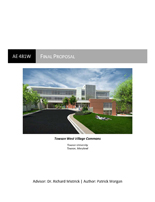Lighting Depth
The lighting design will cover the redesign of five key building spaces, the grand staircase, roof terrace, study lounge, HRL suite, and multi-purpose room. The redesign will meet both ASHRAE and IESNA lighting standards. The premise for design will focus on three main concepts; definability, spaciousness, and sustainability. Various lighting techniques and light sources will be used in each of the spaces. Schematic designs of each space can be seen in Technical Report 3.
Go to Top
Electrical Depth
The electrical depth includes electrical analysis of the lighting redesign, a protective coordination study and two topic areas including DC distribution and a comprehensive short circuit analysis. The lighting redesign will include branch circuit design for the new luminaires and controls. The protective device coordination study will include protection curves and the short circuit current. The studied path will range from the utility transformer, through the switchboard SWB, panels LP4, RP4, RP4A and finally to panel DM4A. The HRL suite will be analyzed using a DC based electrical system. The final area of study is a comprehensive short circuit analysis of the entire electrical distribution system.
Go to Top
Daylighting Breadth (M.A.E.)
The study lounge currently uses three glazing types as its enclosure; fritted, translucent, and clear. The analysis will study removing the translucent and fritted glazing and replacing them with clear glazing to help preserve the views if the West Village Quad. Shading options will then be studied as a possible way to control glare and light levels within the lounge. The breadth will be based on information learned in AE 565, Daylighting.
Go to Top
Mechanical Breadth
When changing the glazing type, heating and cooling loads of a space will be impacted. This analysis will study the effect of changing to an entirely clear glazing facade. Using the Radiant Time Series Method, the shading conditions will be modeled to determine their impact on heating and cooling loads. The heating and cooling load will be analyzed over an entire year using the same weather data the shading conditions were determined from.
Go to Top
Structural Breadth
With the addition of a photovoltaic array for the DC based electrical system, the existing structure will need to support the added load. Wind load, dead load, and snow drift will be studied to see the impacts on the existing structure. The results will determine whether the structure will need to be changed or if the exisiting structure can support the additional load.
Go to Top
|
Final Proposal --
December 10, 2010
|
The revised proposal includes grammatical corrections and clarity of certain details. Details include the goals of the lighting system and the overall look of the outdoor lighting scene. All topics and breadths were approved in the original proposal.
|
Revised Proposal --
January 14, 2011
|


.jpg)